Category Results:
What is Brand?
The brand is the key component of any sales strategy. It is the packaging that companies use to distinguish their product from a competitor’s.
Apple is a brand. So is Amazon. And Chevrolet. Each brand has its own loyal customer base, AND each brand has its own competitive territory. Apple is a tech company, but it’s also a lifestyle company. Amazon is a seller of goods, AND a distributor of video content. Chevrolet is a car. Or a truck. There are many other vehicle brands out there, but Chevrolet has a certain cache among Chevrolet owners – so much so that they will continue to buy Chevrolets even though other brands provide more horsepower, or more comfort, or more towing capacity.
Marketers spend billions of dollars appealing to THREE types of customers:
- 1) the brand loyal customer
- 2) the customer whose loyalty to another brand is wavering
- 3) the customer who is new to the market
Why is Branding Important?
The most successful companies understand their brand, and how to effectively manage the brand’s story, image, and appeal. Apple is a good example. After losing the PC wars to Microsoft, Apple was in dangerous territory, teetering on the verge of bankruptcy and a likely takeover target. In 1997, Apple had an installed base somewhere near 9% of the market. Windows boxes controlled 85% of the market, with a small percentage split among several other competing PC competitors. Today, Apple is a giant, generating more than $200 billion a year and with a market cap of nearly a trillion dollars. How did this happen?
Without a doubt, the single biggest factor was changing how the BRAND appealed to customers. In 1992, Apple products were more expensive, rather banal, and above all, somewhat clunky and unreliable. Today, while the product lines remain more expensive than their counterparts, they are equally reliable. They are innovative. And above all, they are stylish. That last characteristic is KEY to understanding how the brand now operates. Apple is not a technology company. It’s a lifestyle company. How else do you explain people trading in perfectly serviceable iPhone 8s for the new $1k iPhone 10?
Why You Need a Brand Strategy
There’s an old adage in sales, “you can make a living selling something that people need, but you can make a fortune selling something people want.” THAT is the key to Apple’s success.
And that’s the key to your success. As a marketer, you want to create a “want” in customers. For some products, it’s easier than others. Apple has a large, loyal, and hip and trendy customer base. This, in and of itself is enough to bring in new consumers.
But what if you sell commodity goods? Well, again, it comes down to what people “want”. Charmin grabbed a large market share by convincing people its product offered more comfort than competitors. Bounty grabbed market share by convincing people their product was more absorbent. And Chevron introduced “Techron” into their marketing, suggesting that their gasoline was better for cars than Shell’s. Or Valero’s. Or BP’s. It’s not crucial that there be an actual difference, only that the customer PERCEIVES the difference. And that’s BRAND’s role.
The difficulty for marketers is finding a message that works. Just saying your product is “hip” isn’t enough. Taylor Swift using your product while working out is better. That’s endorsement. (Apple Music) Just saying your product tastes better isn’t enough. Blind side-by-side competition is better. That’s taste testing. (The Cola Wars) Just saying your pickup is more powerful isn’t enough. Showing your pickup out-accelerating the competition is better. That’s comparison.(The Chevy Truck Challenge) Simply put, BRAND is the tool you use to sell your product to consumers. It has to appeal to current customers. It has to appeal to new customers. Or a perceived need. Or benefit. But most importantly, it has to create a want.
Build Your Brand
Camp Creative can partner with you to analyze how your brand is perceived and help you build the best relationship you can with your target market. We will help you vividly convey your message and build trust and loyalty with your customers. Let’s get to work.
How to Speak Directly to New Markets Without Damaging Your Brand
YouTube recently asked Camp Creative to help them encourage more people in the Middle East and North Africa to become YouTube creators. Working with YouTube, we chose to record their messages locally, edit them here in San Francisco where their key marketing people were based, then distribute them internationally. The messages were recorded in Arabic and distributed with subtitles and second channel audio. This was true native language marketing.You can view the complete series of Creator Journeys: Stories From Around the World here.
https://www.youtube.com/playlist?list=PLpjK416fmKwTx7NQ8gt4YceyFor4mHomL
Uncovering A Marketing Strategy
A guiding principle of our targeted marketing approach is reaching customers in a voice and manner that feels comfortable. Familiar. Friendly. As consumers, we’re inundated by calls for our attention, and we’ve conditioned ourselves to tune out messages that have no interest.
When Charles Schwab began operating in South Florida, they recognized the potential buying power of the Latino market. To tap into this market, they began translating many of their communications tools: brochures, radio spots, broadcast spots, into Spanish. This form of localization was a common component of integrated marketing plans in other Latino markets, and it made sense to employ this same technique in Miami. But the response to their initial efforts did not match the response they had seen in other Latino markets, so Schwab set about trying to determine why.
As it turns out, the reason was as simple as culture. There are many different Latino cultures in the US. Ranging from Mexico to Panama and Chile to Argentina, Latin America is culturally, ethnically, and socio-economically diverse. In some cities, the dominance of a certain culture, say Mexican culture in Los Angeles, spills over, to the extent that people from other similar cultures are also sensitive to the language and custom of the predominant group. So while somebody might be of Nicaraguan descent, they are STILL Los Angelenos, and will understand and respond to advertising targeting them as part of a broad audience.
But in South Florida, this is not the case. Many of the people in South Florida identify strongly with their own culture, to the exclusion of all others. Without getting too deep into a specific discussion of Miami cultures, let’s just say that Colombians are different from Venezuelans, who are different from Puerto Ricans who are different from Cubans.
Schwab found the Cuban market particularly enticing since Cubans had traditionally made use of investment vehicles such as IRAs and Individual trading accounts. To reach this market, Schwab hired a Cuban agency whose primary practice area was retail for the Cuban market. This agency crafted a message, wrote scripts for radio and TV, and above all, provided the media planning guidance insure an efficient and economical media spend.
There were several key differences between Cuban and other Latino markets. For one thing, Cubans tend NOT to watch TV commercials, but rather, listen to them. This means that any compelling message should be spoken and not shown on the screen. Second, because of Cuba’s political history, the dialect spoken by the actor is critical. Certain dialects carry a certain stigma, and only a native Cuban speaker would be able to differentiate the subtleties. And third, Cubans treat commercial breaks differently, depending upon the program they’re watching. They will sit through telenovelas as though they’re in a theater but will get up constantly during news programs. This means having your ad running during the six o’clock news is nowhere near as fruitful as having it run during Pasión de Gavilanes.
What Brand Marketing Strategy Works Best For New Markets?
These days, there is more localization and niche marketing taking place on internet and web platforms. One key reason is that the metrics are easier to track. For traditional broadcast media, it isn’t always possible to link dollars spent with sales for a variety of reasons. However, the power of broadcast advertising outweighs its relative lack of specificity. For people who desire a more efficient cost per impression, the web is a perfect place for it offers not only very specific stratification but also tremendous geographic reach. An advertiser whose product has limited appeal locally but broad appeal across geographies might be more inclined to use targeted web advertising rather than traditional media. The same can be said for reaching an audience that’s wide but thin.
And just as with the South Florida market, the Arabic language market is comprised of many different cultures with many different customs. Care was taken to ensure the message was both culturally sensitive as well as properly targeted. With 4.3 Million views, the metrics point to content that is resonating.
The potential to target customers in specific demographics is greater now than it’s ever been. But unlike traditional marketing, targeted marketing requires greater insight into the customs, habits, and customs of the target market. Ineffective messaging can result in lost dollars, but insensitive marketing can injure a brand. When targeting specific groups and specific cultures, it makes sense to employ people who specialize in those markets.
How To Interview Anyone About Anything
Over the years my creative team and I have conducted hundreds of interviews for marketing films and videos. Not one of us had any kind of formal training in journalism; but, in the time-honored tradition of fake it ‘til you make it, we learned on the job, becoming better storytellers with each interview.
My first interview was with fashion icon Calvin Klein. CK was introducing their new fragrance Obsession, and my clients wanted Mr. Klein to share his vision for a launch event.
I prepared for the interview — not just by writing questions for him — but by writing questions for me. I asked myself:
- What if he doesn’t understand my question?
- What if he isn’t forthcoming in his answers?
- What do I do if I lose my train of thought?
Whether your interviewee is engaging or dull, surprising or predictable, or memorable or forgettable, is an outcome that can be greatly influenced by you. Pre-interview preparation and solid interviewing practices will make all the difference in the final product.
Here are seven tips we’ve learned from many hours of interviewing that help make our client videos and films come to life.
7 Tips for Conducting an Interview
Tip #1: Do your homework
You’ve heard the saying, “there are no stupid questions.” Well, those people are wrong. When it comes to doing interviews, there is such a thing as stupid questions. And if you ask them, you’ll be in for a short, awkward conversation.
Take the time to study up on both interviewee and subject. And stay organized by writing down your questions in a logical sequence, numbering them in the order you want to ask them.
Tip #2: Have a conversation, not a Q&A
I can’t stress this enough. Successful interviews are conversations. Conversations are about making a personal connection. Be sure to come prepared knowing some things about your interviewee to draw some points of connectivity.
What’s their alma mater, favorite sports team, or charity? What are they passionate about that you can use to energize the conversation? The truth is, as much as your client thinks their customer is in love with their product or service, they are more in love with what interests them.
Any conversation is two-way. If you can get your interviewee asking you questions, then you know they are primed and more likely to engage in the messaging that gets your client to say, “whoa, that was great.”
Tip #3: Know when to shut up
That said, be mindful to let the interviewee do most of the talking. Ask a question and then simply stop talking. And if your interviewee pauses, fight the urge to fill the silence or finish their sentence. Your main job is stay out of the way.
People like to talk about themselves and what they care about — and they’ll do it if you simply let them.
Tip #4: Shape the narrative
At Camp Creative, we conduct customer success interviews for online customer engagement.
We recommend keeping these kinds of videos short and we organize them in a narrative case study style (ie. problem, solution, resolution), which results in a pithy video usually about 2 to 3 minutes in length.
Interviewees are not made aware of this strategy in advance.
Letting them in on the strategic process may seem like a way to get a better interview, but we’ve found, in that case, interviewees are more likely to prepare long-winded statements that conform to a narrative that they think you want to hear. It’s your job to shape the narrative to fit the needs of the marketing story your client wants to tell — not the interviewee’s.
Guide the interviewee by thinking about what statements, or predicates you need to clarify the subject of your client’s message. When you get a response that feels rehearsed or canned, redirect the conversation with new questions that help shape the narrative from the point of view of your client.
Tip #5: Get the framing right
How your interviewee is framed is just as important as what they say.
Framing is an aesthetic choice that influences the look, feel, and tone of your finished video. And there are rules that guide where to place your subject within the aspect ratio for your frame. You may have heard of the rule of thirds, the golden ratio, or golden spiral.

Without getting too deep into theory, they are all ways to describe the mathematical principle involved in creating proportions that are most pleasing to the eye. This optimal framing can be achieved by placing your interview subject in roughly the left third of frame when they look left to right, as in this example:
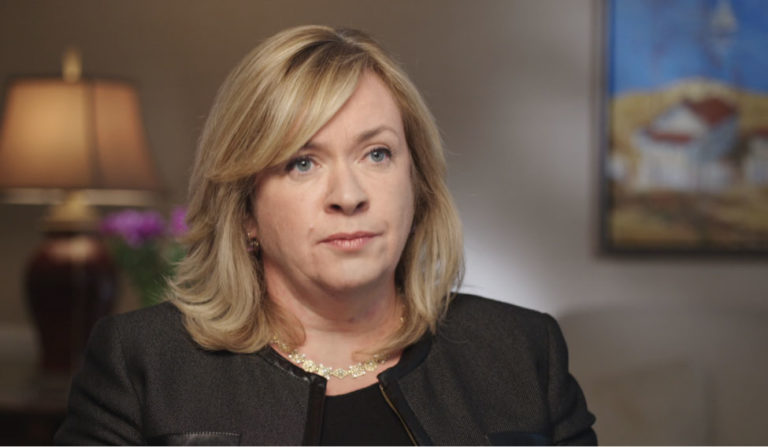
Or the right third of frame when looking right to left, as in this example:

Headroom, either too much or too little, is another consideration. I generally prefer just a little headroom, (see above), for wider frames, with a tighter “haircut” crop on close ups.
Now, let’s break the rules. In a recent shoot for Google, we ignored everything I just told you and centered subjects in the middle of the frame with ample headroom. Why? The subjects of this particular project are rebels, iconoclasts that buck the system and are breaking the conventional rules of the music industry.

Maybe this isn’t the right framing aesthetic for the CEO of a Fortune 500 company; but a break from the norm can add impact when the time is right.
Is your subject a rule breaker? Do they buck the trends? Think about what you know about your subject’s personality, and how it may translate into framing choices that add dimension to the narrative.
Tip #6: Be mindful of eye direction
Nothing bugs me more than sloppy editing that leaves a frame or two of eyes that are shifting away, right at the cut point.
Your subject’s body language can be just as revealing to viewers as what they actually say; and whether an editing mistake or not, eye shifts are a buzz kill for viewers that say, “you can’t trust me.”
How can an interviewer help prevent this kind of situation? By paying attention to eye direction. Eye direction is simply where you’ve got your subject looking as they speak. Interviews are usually conducted in either a more journalistic approach, with subjects looking off camera at the interviewer; or in the popular reality TV format of a confessional, with your subject looking directly into camera..
Direct eye contact with the viewer was perfected by documentarian Errol Morris in the late 80’s with his documentary, The Thin Blue Line. By placing a half silvered mirror at a 45 degree angle to the lens, the subject looks directly into the lens and the director at the same time.
There are a number of devices that make direct eye contact easier and cost effective. My favorite is Eye Direct. It’s available for rental at most camera houses or can be purchased.
Tip #7: Go ahead and wing it
Some of my best interviews have been with CEO’s of Fortune 100 companies. They are typically gifted communicators and comfortable in front of a camera.The CEO of Procter & Gamble AJ Lafley was no exception.
I had 30 minutes of his time for a networking company’s customer video success story. The interview began well, but his responses didn’t reveal anything different from any other P&G technology vendor. He was following the exhaustively vetted questions approved by our client. He wasn’t speaking from the heart.
When I realized this, I pivoted to open ended questions that explored the design of winning strategies and the mitigation of failure. I began to wing it.
As we explored the factors that produce good business outcomes, in this new format, his responses began to offer more insight. They conveyed more of what he wanted to talk about, instead of only what he was expected to talk about. This turned out to be a winning combination.
Incidentally, a few years later, the HBR published an interview with Mr. Lafley titled, I Think of My Failures as a Gift. Reading it a year after my interview, I realized that some of my “winging it” questions prompted answers that I felt failed to get a good response, led to better questions that ultimately succeeded.
Prepare and Practice to Interview Like a Journalist
Not being afraid of failing and knowing when to venture “off script” and just wing it takes some confidence and experience. But there may be, on occasion, extraneous circumstances where you literally have no other option. This is another reason why doing your homework is absolutely crucial.
Telling great stories through compelling interviewing is all about preparation and practice. (And it can often help to have strategic partners, too…) Following these seven tips is a good way to ensure you and your interviewee get the most out of the experience.
19 Spring Cleaning Tips for Better Marketing Optimization
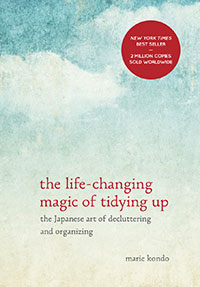 Spring is in full swing, and with it the whole idea of spring cleaning is top of mind. We’ve been talking around the Camp Creative lunch table about the bestselling book, “The Life Changing Art of Tidying Up” from Marie Kondo. Her promise of “…living a clutter-free life forever more” is pretty appealing so some of us are trying her methods, to varying degrees of success. For example, I love the idea of getting rid of clothes that no longer fit but still find the blissful state of knick-knack-free nirvana a little elusive.
Spring is in full swing, and with it the whole idea of spring cleaning is top of mind. We’ve been talking around the Camp Creative lunch table about the bestselling book, “The Life Changing Art of Tidying Up” from Marie Kondo. Her promise of “…living a clutter-free life forever more” is pretty appealing so some of us are trying her methods, to varying degrees of success. For example, I love the idea of getting rid of clothes that no longer fit but still find the blissful state of knick-knack-free nirvana a little elusive.
Regardless, this whole idea of decluttering got me to thinking; us marketers probably have plenty of clutter we can purge. Best practices that we should follow get lost in the shuffle of our everyday hustle and bustle. And in the process our tidy marketing efforts are less efficient — and productive — than they could be. So I’ve put together this list of 18 spring cleaning tips for marketers. Now that the craziness of conferences like SXSW has subsided, its time to do some spring cleaning!
Now, we work with a whole range of companies, from 2-person startups to Fortune 100 companies. So, some of these marketing optimization tips may not apply, especially if you’re in a larger organization with a more focused set of responsibilities.
Tips for CRM and Marketing Automation Platforms
Remove duplicate records from your CRM.
Duplicate entries can cause a whole ton of problems with CRM software. Whether it’s a lazy sales team entering data or improperly configured lead capture forms, there are many ways for duplicate records to creep into your CRM. If you’ve never run a dedupe, or if its been awhile since your last one, do yourself a favor and run an audit on your database for duplicate records. You may be surprised at what you find!
 There are a lot of vendors that provide dedupe software for just about every CRM out there. If you can’t find the budget for an ongoing license, see if you can run an initial dedupe with a free trial.
There are a lot of vendors that provide dedupe software for just about every CRM out there. If you can’t find the budget for an ongoing license, see if you can run an initial dedupe with a free trial.
Remove any obvious bad data or bad leads from your CRM.
Similar to running a dedupe, do some searches in your database for leads who have the first or last name value of, “Test,” or “asdf,” or similar garbage values that can be removed. Cleaning out junk records like this will improve the accuracy of your overall reporting.
Audit your lead database for improperly capitalized records.
Sometimes leads will get entered with improper capitalization of the first name or last name field. For example, “John Smith” gets entered in as “john SMITH.” Leaving these records improperly formatted can make you look a little silly in your email marketing if you use personalization tokens with your emails.
For example, using personalization in an outbound email campaign with this lead record might produce a subject line like this:
 “Hey john! Check out our latest white paper…”
“Hey john! Check out our latest white paper…”
“Hello Mr. SMITH, check out Booth 465 at this trade show…”
“Good Afternoon JOHN…”
It’s AWKWARD. I mean, it’s awkward.
Fortunately, there’s a quick and easy fix: export your data to an Excel sheet, and then use the “PROPER” function to correct everything. You can fix your entire database in under 10 minutes. Then, upload your spreadsheet and append your lead records. Voilà! Once you’ve run this update you can rest assured that your personalized emails don’t look like a 6th grader’s text message. (Check out instructions on Excel’s “PROPER” function here.)
Audit your lead scoring system in your marketing automation tool with some real sales info.
If you are using a marketing automation platform, odds are you are using lead scoring for your nurture campaigns. The thing about these systems is, they are never one-size-fits all. Every lead scoring system has to be customized to a particular company’s needs. If your system has been up and running for a while, the reality of your lead scoring requirements might be different from your initial assumptions during setup.
Take a sample of actual deals that closed, and trace them back to the top of the funnel to their first touch point. For each lead, look at how their lead score accrued as they progressed through your sales funnel, and ask yourself if your scoring system still makes sense. Should they have been upgraded to a marketing qualified lead sooner? Later? Should someone on your sales or marketing team received a notification about some activity that this lead did? Odds are, you will have some adjustments to make with the nuts and bolts of your lead scoring system.
Audit your report and dashboard setup.
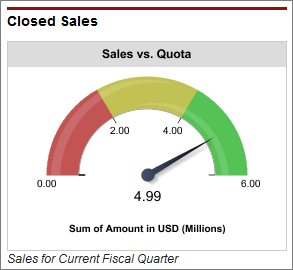
Think about how your team is using your CRM and/or marketing automation platform. Do your reporting templates meet your needs? Does the dashboard/user interface deserve any customization that you may have missed on initial setup? A slight adjustment in the UI might drastically improve your team’s productivity.
Archive outdated landing pages and set up 301 redirects.
If you have landing pages for expired offers, consider archiving them and setting up 301 redirects. For example, if you have a landing page for an offer specific to a trade show from 2014, setup a redirect to the landing page for the 2015 event’s landing page.
Tips for Sales and Marketing Collaboration
Talk to your sales team about what’s working and what isn’t.
Streamlined organizations often have this built into their processes, so this may seem like stating the obvious. But its important so I’ll say it anyways. Go talk to your sales team and ask them what is working! What type of marketing assets do they need more of? What is helping them close deals? What is extraneous? What kind of leads are getting the best response and close rates?
Also, make sure you talk to people at varying levels of the sales organization. Talk to sales execs, inside sales reps, sales development reps, and so on. If there is a sales operations person(s) in your organization, talk to them as well. Your sales ops team might be able to provide you with hard data on what marketing collateral is getting used the most.
 Review your buyer personas and see if they still ring true.
Review your buyer personas and see if they still ring true.
Buyer personas are always evolving. Review your personas with your sales team and see if they still make sense. Do any personas need adjusting? Are any missing? Which personas are driving the most revenue?
Tie off any loose ends with old projects.
Projects get put on hold all the time for a myriad of reasons. Look at your list and see if anything should be revisited or wrapped up. Sometimes reaching out about old projects can lead to new projects for your pipeline.
Tips for Website and Online Presence
 Check your website load time.
Check your website load time.
A slowly loading website can send your bounce rates through the roof. Your site may have been optimized when you first launched it, but any number of factors might have changed since then, affecting your page load times. Check your page load time using a free tool like ping-dom or webpagetest.org.
Check up on your Google Analytics.
If you are involved in your company’s website, you are likely doing this as a regular part of your routine. However, at smaller organizations like startups, oftentimes marketers are so overwhelmed with their to-do list, looking at web analytics gets lost in the fray. Take a look at your your heat maps, bounce rates, traffic trends, and so on.
Review your site in Google Webmaster Tools.
Its always good to know how Google sees your site. Go to your Webmaster tools account and audit/update your XML sitemaps, check for any 404 errors, test your robots.txt file, and given the “Mobilegeddon” update of April 2015, double check the Mobile Usability dashboard. (And if you haven’t heard of Mobilegeddon yet and your site isn’t mobile friendly, I encourage you to read this immediately.)
Check your site in search.
Do searches for your company name in Google and Bing. Find out where you stand in branded search.
Check your competitors’ sites in search.
Where do your competitors stand in their branded search?
Check search engine results for your targeted keywords.
What keyword strings are you ranking well for? What do your competitors rank well for? What are you up against?
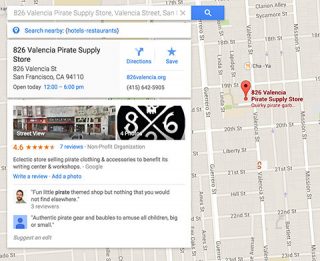
These pirates are on top of their SEO game.
Check your company info in Google Maps and Google+.
It may have been a while since you last checked your Google Maps listing. Not too long ago, Google released “Google My Business” as an easy way to keep your listings up to date. Keeping this information up to date is critical for two reasons. First, your customers know how to find you. The second reason is that you will get a nice SEO boost as a result. (For details on the SEO component of Google+, check out these posts on Social Media Examiner and Moz.)
Check your Yelp listing.
You may be thinking, “I don’t work for the kind of company that is on Yelp.” Even so, someone else may have added your listing without your knowledge. (For example, if someone “checks in” at your office during a job interview.) Take a look at your listing and make sure everything is in order. If you don’t have a listing, create one. This is low hanging fruit for an easy SEO boost.
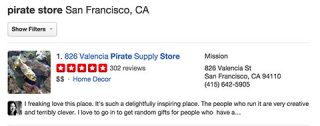
Even swashbucklers use Yelp!
Check in on your social media accounts.
This is going to vary widely from person to person and company to company, but here’s some ideas on what this ‘check-in’ could mean. Is all your profile information current and aligned with the rest of your online presence? If you don’t manage your company’s social account, is the person managing your account doing so effectively? Is he or she clear on the strategy, and what their performance metrics are? Has your social media effort made any contributions to your lead generation? Have there been any negative incidents on social media? If so, are those incidents being handled/managed effectively?
Check your site search functionality.
Check your site’s search feature
If your website has a search feature, put yourself in a customer’s shoes and do a few test searches based on terms they would use. Does the right information pop up in the results?
Do you have any good spring cleaning tips for your marketing programs? Let me know in the comments or message me on twitter @chucktothejones. Happy cleaning!
New Paradigms: Build Your Website for Lead Generation
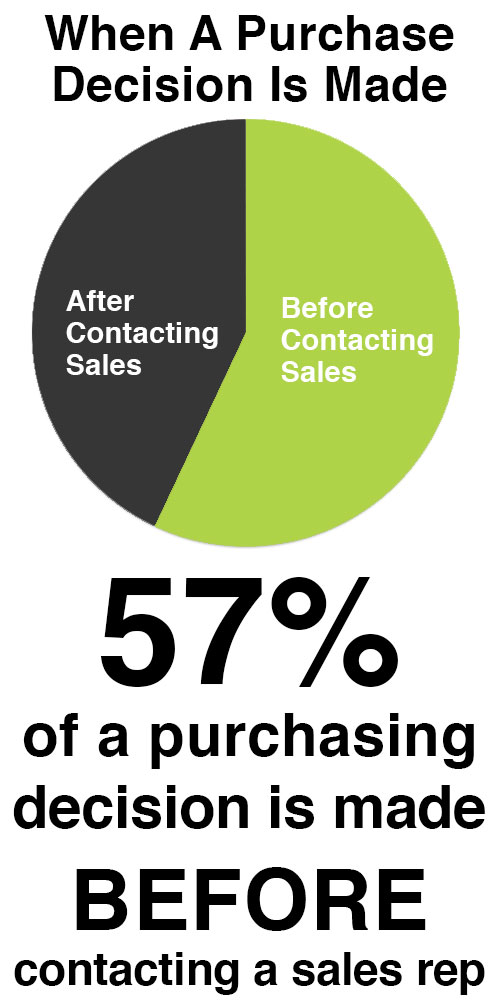 A few years ago, Harvard Business Review published an article with a single statistic that stands out in my mind as the most poignant and relevant data point for the current digital marketing strategy landscape. Although published in 2012, I still see this stat referenced constantly on Twitter, blogs, and at marketing conferences:
A few years ago, Harvard Business Review published an article with a single statistic that stands out in my mind as the most poignant and relevant data point for the current digital marketing strategy landscape. Although published in 2012, I still see this stat referenced constantly on Twitter, blogs, and at marketing conferences:
“A recent Corporate Executive Board study of more than 1,400 B2B customers found that those customers completed, on average, nearly 60% of a typical purchasing decision—researching solutions, ranking options, setting requirements, benchmarking pricing, and so on—before even having a conversation with a supplier. In this world the celebrated “solution sales rep” can be more of an annoyance than an asset. Customers in an array of industries, from IT to insurance to business process outsourcing, are often way ahead of the salespeople who are “helping” them.”
(Sources: Harvard Business Review & CEB)
Let that sink in for a second. Today, buyers have their decision mostly made before they have any conversation with your sales team. The article is appropriately titled, “The End of Solution Sales,” and makes the case that, “boosting the performance of average salespeople isn’t a matter of improving how they currently sell; it involves altogether changing how they sell.” How your sales team should adapt is something I’ll explore further in another post. What I’d like to focus on is what this means for your website.
This shift in buyer behavior means that now more than ever, your website is a critical component in the sales process. It is the public face of your company, and is often the first thing a potential customer will see when considering your product or service. Granted, every online touch point is important, social media or otherwise, but your company’s site serves as the central hub for potential customers as they go through their purchase decision process.
The good news is, you can make this shift in buyer behavior work to your advantage. Your company’s website can be turned into a lead generation machine, attracting traffic, converting unknown traffic to leads, and nurturing leads into customers. To do this, your website should incorporate the following:
 Get found online with search engine optimization (SEO). Make sure that your website is playing nice with Google. This includes a combination of on-page optimization and off-page efforts. A well-optimized site will appear higher in search engine results pages (SERPs). The top result in a Google search typically gets 36.4% of clicks.
Get found online with search engine optimization (SEO). Make sure that your website is playing nice with Google. This includes a combination of on-page optimization and off-page efforts. A well-optimized site will appear higher in search engine results pages (SERPs). The top result in a Google search typically gets 36.4% of clicks.
Make sure your site is designed for usability. Most sites in most industries have a 30-60% bounce rate, meaning that visitors come to a site and immediately leave. Sites that are designed for usability ensure that traffic that visits the page stays on the page, lowering bounce rates.
 Get the right content on the site. Having content that is relevant and useful to your site’s visitors is an absolute must-have for your website to generate leads.
Get the right content on the site. Having content that is relevant and useful to your site’s visitors is an absolute must-have for your website to generate leads.
Make sure you can convert traffic to leads. Once an anonymous visitor comes to your site, make sure that your site enables them to provide their information and become a lead that you can nurture. This is typically done through call-to-action buttons and javascript-based lead capture forms.
For an in depth look at turning your website into a lead generation machine, check out our Ebook, “25 Essential Website Elements to Drive Traffic, Leads, and Sales.”![]()
Get Ready for the Google Algorithm Update April 2015: Mobile SEO
“Mobilegeddon” is coming April 21. Get your site’s mobile SEO ready now.
Every few years, Google releases a major algorithm update that has a dramatic effect on how your site appears in a search engine results page (SERPs). Recently, Google announced a new algorithm update focused on mobile search:
Starting April 21, we will be expanding our use of mobile-friendliness as a ranking signal. This change will affect mobile searches in all languages worldwide and will have a significant impact in our search results. Consequently, users will find it easier to get relevant, high quality search results that are optimized for their devices.
What does this all mean? If your site is not optimized for mobile devices, you will lose out in search results to your competitors that are mobile-friendly. One nuance of the update is that it is on a page-by-page basis. For example, if your home page is mobile-friendly but other pages are not, you will be penalized in SERPs. You can verify your mobile status with Google’s Mobile-Friendly Test Tool, and get more granular data on any issues your site is having with Google Webmaster Tool’s Mobile Usability Report.
The folks over at Search Engine Land, Search Engine Watch, and Moz have all done great write-ups on the pending update, full of great tactical advice on how you can prepare for the change. Marketing TechBlog has also put together a nice guide on mobile SEO in infographic format. If you are concerned about your site’s mobile SEO and how you can be prepared for the Google algorithm update April 2015, feel free to get in touch with us.
Get To Know The Marketing Metrics That Matter
These days as marketers, we are flooded with metrics. Website traffic. Bounce Rates. Followers. Likes. Conversion rates. The list goes on and on. With so many marketing metrics its easy to lose perspective on what metrics really matter: the ones that show marketing’s contribution to the bottom line. When presenting to C-level executives, marketers should focus on those metrics that demonstrate ROI.
One key metric for marketers is a company’s Customer Acquisition Cost (CAC). The CAC shows how much a company is spending to get a new customer. It is calculated by taking the overall sales and marketing cost and dividing that figure by the number of new customers acquired in a given month.
For example:
Sales and marketing cost: $100,000
New customers acquired in a month: 10
CAC = $100,000 ÷ 10 = $10,000 per customer
An increase in CAC means that new customers are costing you more, which may indicate a problem with your sales or marketing efficiency. Imagine how happy your boss will be when you can provide hard numbers on sales and marketing efficiency!
To learn more about the marketing metrics that have real meaning for C-level executives, download our Ebook, “6 Marketing Metrics That Your Boss Actually Cares About.”
Forget Big Data, Get Smart Data – Market Research for Real Insight
Futurist John Naisbitt once said,
“We are drowning in information
but starved for knowledge.”
In today’s world of big data, this is especially true. As marketers, we are often overwhelmed with data but lack real, actionable insight. How can one cut through the noise of information overload and get to the real, actionable insights that matter? And once you have that insight, how do you effectively communicate it to your audience?
We’ve teamed up with market research experts The Connell Group on a webinar to answer these questions. In this webinar, we’ll address:
- How to extract actionable insights from your market research or data sets
- How to convert those insights into compelling content
- Criteria for how to communicate your insight to your audience, whether its through data visualization, websites, social media, video or some other medium
How a Common Hollywood Screenwriting Technique Can Transform Your Marketing – Part 3 of 3: The Hero’s Journey For Brands
In my previous posts, I argued that telling stories is the most effective way to market your product or service. I also outlined the history of The Hero’s Journey narrative framework and how Hollywood has used it for years to craft blockbuster story lines. In this post we’ll look at how The Hero’s Journey can be leveraged for your brand.
For your marketing efforts, you can use Joseph Campbell’s, ‘Hero’s Journey’ framework to create compelling stories around your product or service. To review, here is a diagram of that framework.

The key to using the framework in a marketing context is to place your customer into the role of the Hero, and your product or service takes in the role of the Mentor. Once you do this, your marketing story starts to take shape. Whether you are working on a product launch with many marketing touch points or scripting your next marketing video, the ‘Hero’s Journey for Brands’ can help. Obviously this is not a panacea for every piece of marketing collateral you create, but a surprising number of assets can be created or enhanced with this framework.
We use this framework so much in the work we do for our clients that we have created an abbreviated version of the Hero’s Journey specific to content marketing. Our abbreviated steps are:
The Hero’s Journey For Brands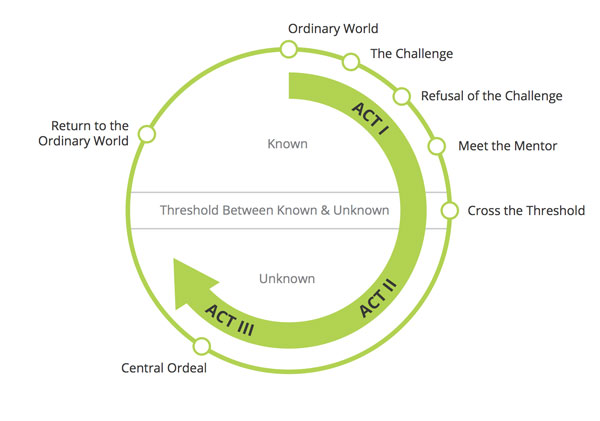
- Ordinary World – We see the Hero in his or her ordinary world.
- The Challenge – We identify the Hero’s need or problem.
- Refusal of the Challenge – They hesitate because change isn’t easy.
- Meet the Mentor – They are introduced to your brand’s value proposition.
- Cross the Threshold – The Hero takes the leap of faith, possibly due to some proof point you can offer.
- Central Ordeal – They agree to adopt/use your product or service.
- The Return – The Hero returns to their ordinary world, their challenge resolved with the help of your product or service.
Ready to put it into practice? We’ve created a PDF worksheet for you to apply the framework to your product or service. To learn more about the ‘Hero’s Journey’ and access the worksheet, download our free E-book:
Or, watch our archived webinar:
How a Common Hollywood Screenwriting Technique Can Transform Your Marketing – Part 2 of 3: The Hero’s Journey
In my previous post, I made the case that marketers are more effective when telling stories because it satisfies a fundamental human desire. In this post we’ll take a look at the history of The Hero’s Journey’s narrative framework.
Story telling predates writing; it has been with us since the dawn of humanity. However, it’s only relatively recently that anyone explored how or why we need to tell stories. At the beginning of the 20th century, Sigmund Freud and Carl Jung were pioneering the field of psychology and uncovered important truths about the human psyche; storytelling gives the present meaning and helps make sense of the world we live in. They introduced the concepts of a collective unconscious and archetypes.
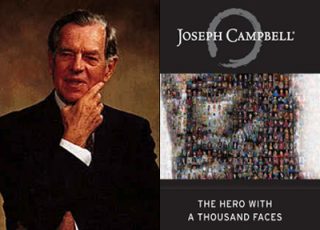
In the 1930’s and 40’s a professor at Sarah Lawrence College named Joseph Campbell taught an introductory course on mythology. His research led to the publication of The Hero With a Thousand Faces, a treatise on storytelling across cultures. Influenced by many of Jung’s ideas, Campbell’s research showed similarities in mythology across cultures. He claimed that these myths are actually different versions of one underlying eternal theme, which he called the ‘mono myth.’ In the mono myth, there is a hero character that goes on a journey, encountering several archetypical characters along the way.
Here are the steps of the Hero’s Journey outlined by Campbell:
- Ordinary World – The Hero begins in an unremarkable world of normalcy.
- Call to Adventure – Our Hero receives a call to head off into the unknown.
- Refusal of the Call – Frequently, the Hero is reluctant to answer the call. This could be due to fear, insecurity, or other reasons.
- Meet the Mentor – The Hero meets a supernatural or spiritual guide.
- Cross the Threshold – This is the point where the Hero crosses from his/her ordinary world into the unknown.
- Tests, Allies, Enemies – The Hero must endure a series of tests or challenges to begin their transformation.
- Approach – Setbacks occur, sometimes causing the Hero to try a new approach or adopt new ideas.
- Central Ordeal – The Hero encounters a major obstacle or hurdle.
- The Reward – The Hero survives death, and earns a reward or accomplishes his/her goal.
- The Road Back – The Hero begins his/her way back to their ordinary world.
- Resurrection – A final test, where the Hero must summon all of his/her knowledge.
- Return With the Elixir – The Hero returns home and applies their new found knowledge or power.
Without meaning to, Joseph Campbell wrote a how-to guide for screenwriters. The Hero With A Thousand Faces became tremendously influential for Hollywood writers who employed the framework to craft plot lines, most notably with George Lucas and Star Wars. In fact, George Lucas claims that without Joseph Campbell, he would “…still be writing Star Wars today.”
Watch a young George Lucas give thanks to Joseph Campbell:
What does this look like in practice? Here’s how Star Wars maps to the Hero’s Journey:
- Ordinary World – Luke at home
- Call to Adventure – Leia’s message
- Refusal of the Call – Luke can’t leave because he has to help with the harvest
- Meet the Mentor – Obi-wan rescues Luke from the sand people
- Cross the Threshold – Luke escapes Tatooine
- Tests, Allies, Enemies – Lightsaber practice, Han and Chewie, stormtroopers
- Approach – Luke and allies move towards the Death Star
- Central Ordeal – They free the Princess
- The Reward – They capture the Death Star schematics
- The Road Back – Death Star has moved closer to the Rebel camp
- Resurrection – Luke destroys the Death Star by sacrificing part of his old self (his dependence on machines)
- Return With the Elixir – They are rewarded with medals
Today, the Hero’s Journey framework is everywhere. It is so prevalent in Hollywood blockbusters that it is difficult to find a large studio backed film that doesn’t follow the Hero’s Journey closely. Films like The Matrix, Finding Nemo, The Incredibles, and many, many, more all map closely to Campbell’s framework.
Read the next post, “How a Common Hollywood Screenwriting Technique Can Transform Your Marketing – Part 3 of 3: The Hero’s Journey For Brands.” (coming soon)
If you’d like to learn about the Hero’s Journey and how it can help your brand, download our free ebook here:
Or, watch our archived webinar:
How a Common Hollywood Screenwriting Technique Can Transform Your Marketing – Part 1 of 3: The Content Marketing Dilemma
In this three part series, I’ll examine how marketers are increasingly tasked with creating quality content. I’ll define and outline a narrative framework called ‘The Hero’s Journey,’ and how you can use it to improve your content marketing efforts.
Let’s face it, traditional marketing is dead. Or, at minimum it’s on life support. Content marketing – creating, curating and sharing relevant information and ideas with your customers – is the new normal. The key word here is relevant. When you share knowledge that resonates with consumers you’ve given them a real reason to seek you out and engage with your brand. You have a unique insight or knowledge set. Share it with customers (and potential customers) and you’ve made an investment that can help shape your brand’s perception and define your customer relationships.
If you’re currently engaged in content marketing and find that your content is increasingly ignored ask yourself, is the content too bland to ignite any real interest or too similar to other content to garner attention? There are millions of tweets and blog posts, each proclaiming that ‘quality content is king,’ (and they aren’t wrong). But too few tell you how to improve your content to make it eye-catching, interesting, relevant, and share-worthy. The marketer’s dilemma is then, “How can I consistently create quality content that my customers want to engage with?”
 This contemporary problem can be solved with one of the oldest crafts known to humans, the art of story telling. Specifically, we think the framework of The Hero’s Journey is the perfect structure upon which to build your brand’s story. Ok, ok… I know… you’re probably rolling your eyes right now thinking that this is some solipsistic “liberal arts” nonsense. “What does storytelling have to do with marketing?” The short answer is, “Everything,” but first, let’s take a step back and look at the economic power of storytelling.
This contemporary problem can be solved with one of the oldest crafts known to humans, the art of story telling. Specifically, we think the framework of The Hero’s Journey is the perfect structure upon which to build your brand’s story. Ok, ok… I know… you’re probably rolling your eyes right now thinking that this is some solipsistic “liberal arts” nonsense. “What does storytelling have to do with marketing?” The short answer is, “Everything,” but first, let’s take a step back and look at the economic power of storytelling.
According to the US Department of Commerce, the film industry took in $31 Billion in domestic revenues in 2013. Worldwide, the video game market surpassed $93 Billion during the same period. The US publishing industry took in $27 Billion in 2013. Worldwide, people spend hundreds of billions of dollars to read, watch, or listen to stories in movies, television, books, magazines, newspapers, websites, and so on. The ‘story industry’ is a major force in the global economy.
Harry Potter, World of Warcraft, Real Housewives of Atlanta, and a how-to video on your website have very little in common. Except, each taps into the most basic of human desires; the need to hear and share stories. Savvy marketers realize that pushing product features and benefits aren’t going to cut it any more. They create stories that bring those features and benefits to life and follow the classic creative writing rule of, “show not tell.”
So, if we accept the premise that your marketing can be improved through story telling, how can you make a marketing story pop? This is where the Hero’s Journey framework comes in. What is the Hero’s Journey framework? Stay with me now… we’re taking an elevator straight to the top of the ivory tower of academia….
(BTW, if you’re thinking that this blog is an example of content marketing – Spoiler Alert – you’re right.)
Read the next post, “How a Common Hollywood Screenwriting Technique Can Transform Your Marketing – Part 2 of 3: The Hero’s Journey.”
If you’d like to learn about the Hero’s Journey and how it can help your brand, download our free ebook here:
Or, watch our archived webinar:
Google Plus for Business: 8 Things You Should Be Doing Now
With more than 300 million active users per month, Google Plus is a natural platform for business owners looking to expand their reach. Whether you’re just getting started using Google Plus for your business, or you have a profile on Google Plus and want to improve your platform usage, these eight tips can help you make the most of your Google Plus presence.
 1. Link your Google Plus and YouTube accounts – Since YouTube is owned by Google, you can link your business accounts across these channels. This boosts your YouTube credibility with a verification badge, merges comments on both platforms, and makes it easier for fans to see your content.
1. Link your Google Plus and YouTube accounts – Since YouTube is owned by Google, you can link your business accounts across these channels. This boosts your YouTube credibility with a verification badge, merges comments on both platforms, and makes it easier for fans to see your content.
 2. Add G+ buttons to your website. Adding G+ buttons to your website improves your discoverability on Google Plus. The Google+ Follow button lets viewers automatically follow you on Google Plus without leaving your website. The +1 button lets them automatically like your content without leaving the page, and the Share button lets them share it. Increase your reach without sacrificing conversion rate by adding these buttons to webpage content.
2. Add G+ buttons to your website. Adding G+ buttons to your website improves your discoverability on Google Plus. The Google+ Follow button lets viewers automatically follow you on Google Plus without leaving your website. The +1 button lets them automatically like your content without leaving the page, and the Share button lets them share it. Increase your reach without sacrificing conversion rate by adding these buttons to webpage content.
3. Create a +Post ad. +Post ads turn native Google Plus posts into targeted ads. This is one of the subtle Google Plus for business tips that helps you grow your reach without annoying readers with excessive ad saturation.
4. Include hashtags in all posts. Hashtags are a key part of social media for business because they increase discoverability and connect you to key players in your niche. Consider them a must on Google Plus, especially as hashtags used in posts appear on Google Search in the sidebar.
5. Create a Google My Business Page. If your business has a physical location, Google My Business presents customers with your online information whether they’re searching Maps, Search or Plus. From the Home menu, select Pages, then Get My Page to begin creating your Google My Business Page.
6. Run effective Hangouts on Air. Hangouts on Air (HOA) lets you broadcast video conversations on Google Plus, YouTube and your website. If you videoconference, these are a must. For more information about how to schedule, broadcast and do an HOA, including technical requirements, refer to the Google Partner Playbook.
7. Learn from it all with Insights. Insights lets you track Post, Hangout or Video performance over time and see demographic details about your followers. Knowing this information can help you connect better with your audience and refine your approach.
8. Follow social media for business best practices. Along with the above tips, keep in mind best practices regarding the content and frequency of social media posts to create engaging content that entertains, informs and does not annoy your user base.
These are our favorite tips for working with Google Plus for Business; they’re the ones we use ourselves as well as advise our clients to use. If we’ve left any out that you swear by, let us know in the comments. To learn more about Google Plus for Business, checkout the Google Plus Partner Playbook we created in collaboration with the Google Plus team.
Do you need assistance with your company’s social media presence? Contact us:

Don’t Sell Your Story, Tell It. Discover the ‘Hero’s Journey’ and Your Brand
Saavy technology marketers know that creating great content is the key to generating leads. With technology marketing, crafting meaningful and useful content poses a constant challenge. How then can you make your brand, product, and marketing collateral more compelling? Take a page from Hollywood’s playbook and leverage the ‘Hero’s Journey.’
The![]() Hero’s Journey is a narrative framework first posed by academic Joseph Campbell in his book, The Hero With 1000 Faces. George Lucas claims that if he hadn’t read this book, he would “still be writing Star Wars today.” Thousands of Hollywood movies utilize this framework to pack movie theaters across the globe, including Star Wars, Harry Potter, The Matrix, and Finding Nemo. But its more than just a way to write blockbuster screenplays!
Hero’s Journey is a narrative framework first posed by academic Joseph Campbell in his book, The Hero With 1000 Faces. George Lucas claims that if he hadn’t read this book, he would “still be writing Star Wars today.” Thousands of Hollywood movies utilize this framework to pack movie theaters across the globe, including Star Wars, Harry Potter, The Matrix, and Finding Nemo. But its more than just a way to write blockbuster screenplays!
Join us on Tuesday, December 9th at 11:00 am for this webinar where our creative director Brian Leonard will teach you what the Hero’s Journey is, and how you can use it to punch up your marketing to craft great content.
Webinar: Don’t Sell Your Story, Tell It. Discover “The Hero’s Journey” and Your Brand.
Make Any Marketing Collateral Compelling
Archived Webinar





